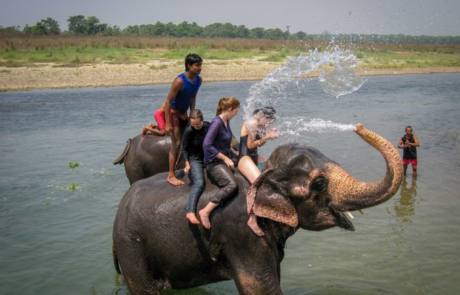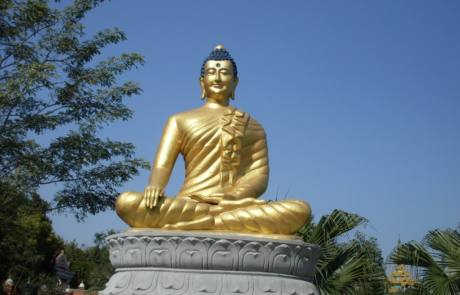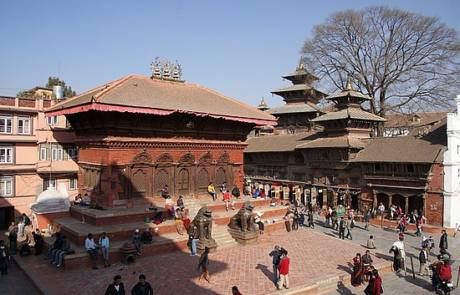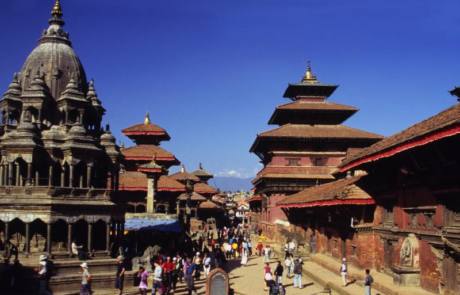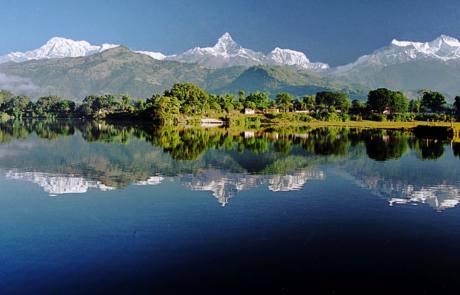6 DAYS/5 NIGHTS
KATHMANDU AND CHITWAN
ABOUT
Nepal is a land of extreme contrasts in climate and geography, It has a unique topography ranging from lowlands with sub-tropical jungles to arctic conditions in the Himalayan highlands. Within a mere 150 kilometers the land rises from near sea level in the south to over 8000 meters in the North. This, together with the monsoon rainfall along the south facing slopes, has resulted in compacting virtually all climate zones found on planet Earth. As a result, Nepal has been endowed with a great diversity of life-zones providing a home for a large variety of plants, birds and animals.
The Terai lowlands are defined by a belt of well-watered floodplains stretching from the Indian border northward to the first slopes of the Bhabhar and the Siwalik Range. This is the richest habitat in the land with tall grasslands interspersed with riverine and hardwood sal forest . Here one can see wildlife such as the swamp deer, musk deer, black buck, blue bull, the royal Bengal tiger, gharial and marsh mugger crocodile and the last of a breed of Asiatic wild buffalo. This area is also rich in birdlife with a variety of babbles and orioles, koels and drongos, peacocks and floricans, and a multitude of wintering wildfowl. There are five protected areas in Nepal – Koshi Tappu and Parsa in the east, Sukla Phanta and Dhorpatan for hunting in the west and Shivapuri in the. mid-mountain region. The Churia, also known as the. siwalik, is the southern most range of the Himalaya. No where do they rise above 1,220 meters, This range is famous for fossil deposits of Pleistocene mammals, among them 10 species of elephants, 6 rhinoceros, hippopotamus, saber-toothed cats, various antelopes and primates such as the orang-utan, long extinct in the subcontinent, Situated north of the Churia are broad, low valleys of the inner Terai know as the Doons. These valleys are not unlike the outer plains with tall elephant grass, swamps and ox-bow lakes where the last of the one-horned rhinoceros survive.
Royal Chitwan National Park in the Inner Terai of central Nepal is the first and best protected area in the kingdom. Once one of the most famous big game hunting areas in Asia. Chitwan now offers protection to a large array of mammals such as the. one-horned rhinoceros, tiger, leopard, sloth bear and the gaur (wild bison) as well as more than 400 species of birds….
Pre-departure planning is important.
Here are certain things you should watch for and plan for.
Visas
Check with the appropriate consulate or embassy in your country to find out if you will need a visa to visit the country of your destination, especially for an extended period of time. Some countries have extremely detailed and complicated entry/departure laws, and treat visits of a week or two very differently from longer stays.
Money
If you’re traveling to one area, check the cost of living there. If it’s high you’ll probably want to budget more carefully and save some money before leaving. The lower the cost of living the less you’ll have to save, but be sure to have a back up reserve in emergency cases.
General Tips
Talk to other people who have done a similar trip.
If you don’t know anyone personally, try any of the dozens of online travel web sites full of first-person travel stories covering every possible type of trip.
Plan big and loose. Read everything you can about the area.
There may be sights and attractions you didn’t know about. A rough outline of your trip might have three or four target points and a variety of ways to get between them.
You don’t want to find out that the weather isn’t what you thought, or the guide book was incorrect, after committing to 6 weeks in a specific spot.
Some trips will allow you more leeway than others. Travel plans in Asia can often be made day-by-day while summer travel in Europe should be organized at least a few weeks ahead, unless you’re prepared to hunt around for hotel rooms and train seats.
Set up a pre-trip time-line so you don’t end up with a full todo list your last week of work or school.
Things to consider are doctor’s visits for a check up, inoculations, and prescription refills; purchasing plane tickets; renewing passports and obtaining visas and other documents.
Check your insurance coverage abroad and purchasing additional travel insurance if needed. Don’t forget visiting friends and family members!
The longer the trip, the lighter you should pack. This might seem strange, but it’s true you can afford to lug a heavy bag around for a week or two, but do you want to have anything extra for a year?
Stick to the absolute basics and know what you can and cannot buy at your destination(s). There’s no point in bringing 6 months of toothpaste to Europe or buying a sarong at home to take to the tropics. If you are visiting several climates, try to arrange it so you visit the warmer places first and coldest last. That way you can purchase sweaters and long pants and not have to carry them any more than needed. Alternately, visit cold climates first and then ship unneeded layers home — or sell them off.
A good rule of thumb is to bring one outfit for the hottest day you’re likely to encounter, one for an average day, and one for the coldest.
Make sure everything goes with everything else (if that’s important to you), and remember that layers are always best.
Be prepared for uncomfortable trips. You will often find yourself in a busy, cramped, economy class environment and it could be for many hours – especially long plane trips.
If you want to arrive at your destination refreshed and able to enjoy the sights, then try a good quality travel pillow to support your head, some ear plugs to block out the screaming babies, and an eye cover to block out the sun or cabin lights.
Just avoid those cheap U-shaped pillows from airport shops – your head drops forward and you wake up with a stiff neck.
Make contact with the locals before you go.
Maybe you have a friend-of-a-friend or a foreign exchange student from high school you remember, or just found a friend through a travel web site; almost everyone is happy to welcome a foreign visitor to their home town. This might be as elaborate as a home-stay for a few weeks, or just coffee in their home town or dinner at a locals restaurant.
Trip Attractions
Elephant ride
Canoe Ride
Nature walk
Elephant bathing
Travel Resources
Travel planning is about more than just knowing where you’re going. Prepares to navigate, take control and be ready for anything. This section helps you steer clear of disaster and stay open enjoy the unexpected.
Quick Tips
- Banks – Open Monday to Friday 9am to 2pm. Some banks are closed for lunch.
- Emergencies – For police, dial a local phone number; for ambulance call a hospital.
- Internet Access – Wifi is standard in most hotels and free in many coffee shops.
- Mail – Buy stamps at the Post Office. Convenient post offices are located all cities. Most are open Monday to Friday 9am to 3pm.
- Safety – Pickpocketing can be a common problem. It is suggested for men to keep wallets in their front pocket. Purse snatching also occurs at times.
Visitor Information
This site contains information with a very personal and friendly structure. It also has great links to other related sites online.
Information, internet access, maps, and train passes are available at local Tourist Information terminals. These are located at various sites around the city. Expect a wait if you arrive late in the afternoon or during lunch time. Local travel agencies are also helpful for quick information and finding hotels. There is no service charge for these services. Hours are Monday to Friday 9am to 5pm, and Saturday 10am to 2pm.
Transportation
Getting in from the airport and other arrival locations. Travel planning is about more than just knowing where you’re going. Prepares to navigate, take control and be ready for anything. This section helps you steer clear of disaster and stay open enjoy the unexpected.
- Plane – Flights arrive at the main airport near city center. If flying from European cities, you might land at a connecting airport. There is a tourist information office at the Terminal E, international arrivals, open 8am to 6pm.
- Train – A train station is on the lower level of the airport. To get into the city, follow the marked signs.
- Taxi – From the airport there is a flat-rate for the 1-hour trip, depending on traffic. Hotels charge up to $80 for shuttle service.
- Train & Bus – Trains and buses arrive a city center. This is the transportation hub for the city and is surrounded hotels.
A perfect place for exploring on foot, with local shops around every corner. You will eventually walk somewhere, it’s just going to happen. If you don’t like crowds, uneven cobblestones, heavy traffic or narrow sidewalks, take a taxi or rent a scooter.
Itinerary Details
Day 01 :
Welcome to Kathmandu! You will be met by our representatives and transferred to your hotel, welcome drink at hotel. Overnight at hotel in Kathmandu.
Day 02 :
In morning after breakfast proceed for sightseeing of Boudhanath, Pahupatinath, Shyambhunath and Kathmandu Durbar square. Overnight at Hotel.
Day 03 :
Early Morning breakfast and drive to Chitwan National Park.
Arrive to the hotel welcome drink rest then
1:00 P.M. Lunch
3:00 Elephant ride/ Nature walk/ canoe ride
7:00 Dinner
Day 04 :
Chitwan National Park
5:30 A. M. Wake up call
5:45 Tea/coffee
6:00 Elephant ride/ bird watching
8:00 Breakfast
9:00 Canoe ride/ elephant briefing/ swimming and bath
1:00 P.M. Lunch
3:00 Elephant ride/ Jungle drive/ canoe ride
7:00 Dinner
Day 05 :
Morning free for packing
8:00 Breakfast
9:00 Departure from the chitwan and fly/drive to Kathmandu over night hotel.
Day 06 :
Drive to Airport for your onward journey.

